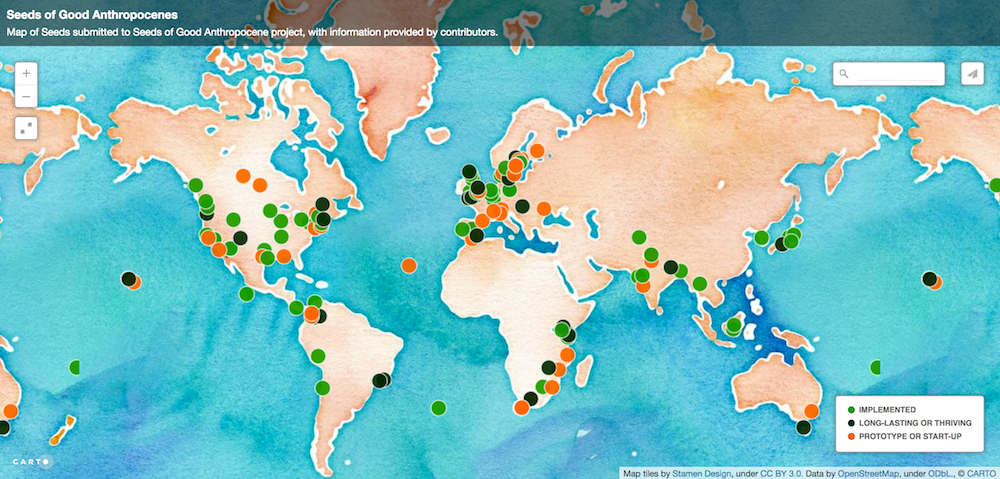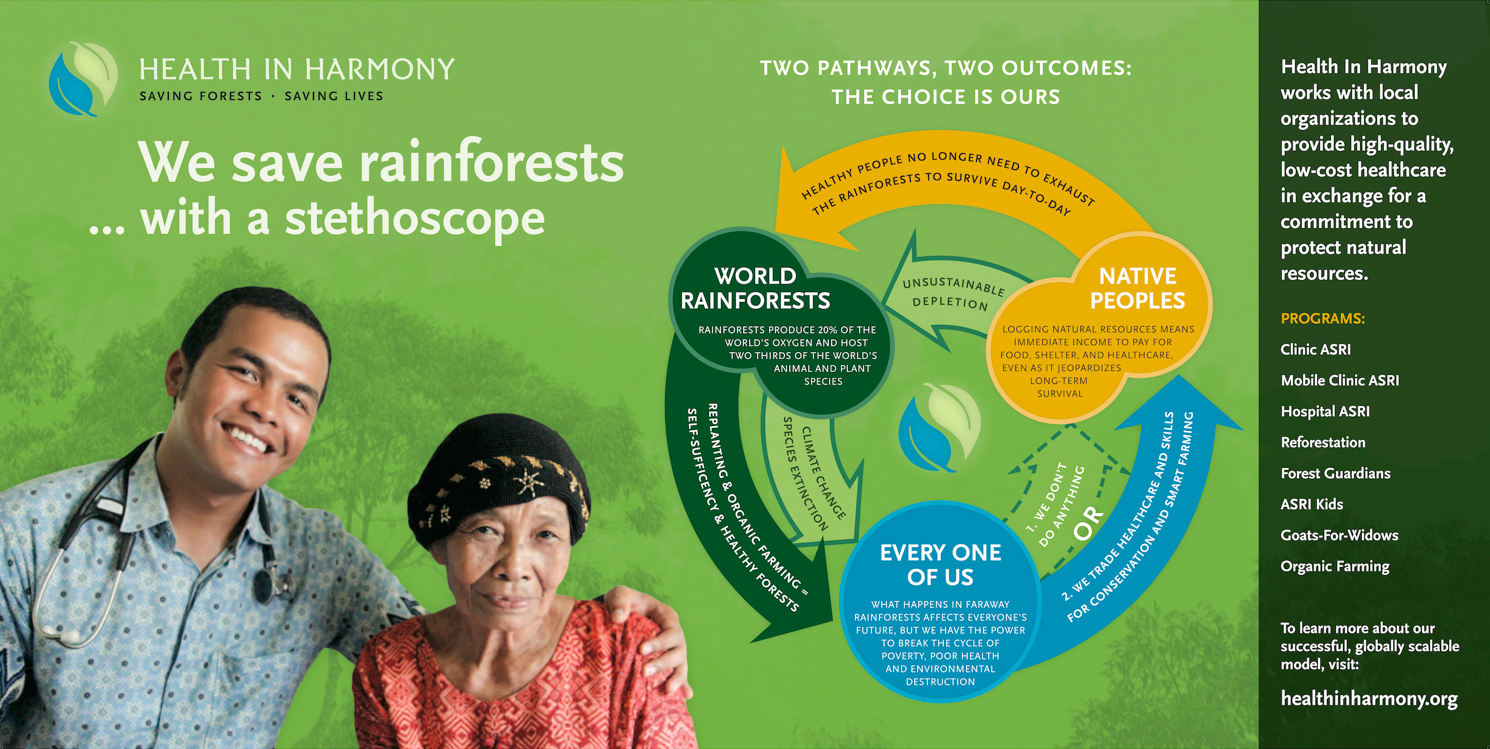“Seeds” project offers glimpse of brighter futures
“How do you retain hope in a time that isn’t hopeful?” asks Elena Bennett, Associate Professor at McGill University in Montreal, Canada. She is one of the founders of Seeds of Good Anthropocenes. This research project, which emerged from an initiative funded by Future Earth, seeks to push back on the negative visions of the future that face people living around the world – from dire outlooks around warming temperatures to distopian stories in pop culture. Through the project, Bennett and her colleagues have built a database of more than 500 examples, or “seeds,” of efforts in which people have transformed their communities in positive ways.
Seeds of Good Anthropocenes captures a range of seeds. They include smaller-scale initiatives to improve the quality of life in local communities. Grassroots Economics, for example, helps informal settlements and other locales in Kenya to develop their own “community currencies.” But there are also technology-driven case studies, such as Revive and Restore. This organisation promotes genetic techniques to revive vanished species, a controversial strategy called “de-extinction.” Bennett says that by collecting these examples, scientists may be able to piece together concrete strategies for how people can work toward better futures – in ways that are realistic and just.
Bennett spoke about Seeds of Good Anthropocenes at the annual meeting of the World Economic Forum, commonly called the Davos meeting after its location in Switzerland, in January 2017. She recently sat down to discuss what she has learned from the project with Future Earth.
Bennett serves as co-Chair of the Scientific Steering Committee of ecoSERVICES, a global research project of Future Earth. The research project Programme on Ecosystem Change and Society (PECS) has also supported Seeds of Good Anthropocenes. This effort is led by McGill University, Stockholm Resilience Centre at Stockholm University in Sweden and the Centre for Complex Systems in Transition (CST) at Stellenbosch University in South Africa.
To learn more about this project or to submit your own seed, visit goodanthropocenes.net.

Daniel Strain: So we all know that when you watch movies or turn on the news, the future looks bleak. You’ve said that these negative visions aren’t just disheartening. They can also be self-fulfilling. How so?
Elena Bennett: When we hear stories or are presented with visions, we naturally tend to make decisions that aim toward those stories, whether they’re stories that we want or stories that we don’t want. In the case of stories we don’t want, it’s like seeing a deer on the road while you’re driving. As you look over at the deer, you tend to turn the wheel at the same time toward the thing you’re looking at. It works the same way with stories – we unconsciously steer towards the stories we’re most familiar with.
DS: But you point out that positive, optimistic stories can be similarly counter-productive.
EB: There are also some issues with the positive scenarios or stories we’ve been told. Many of them feature what I call “and then a miracle happened” moments when everyone decides that sustainability is worth doing, and, magically, the things we know we need to do start happening.
The problem with scenarios that have this magic moment is they don’t give us a clear sense of a plan, or map a way forward. They don’t explain how or why people suddenly decide to change their behaviour or purchasing or the way they get around town. Those types of changes are hard to make. We might all believe that we should drive less, but unless there is infrastructural change that brings houses closer to amenities or amenities closer to houses or shortens the effective distance through easy public transportation, we end up needing to continue to drive because it’s what we’re used to.
So what we’re looking for in our scenarios is to figure out how you get from here to a positive Anthropocene in a way that’s a little bit more realistic, more mapped out.
DS: And it looks like you’ve captured a wide range of ways to get from here to there.
EB: Yeah, we try to get a big range. We have some seeds that are really techy and some that are really low-tech, but with that said, there are some commonalities across them as well.
DS: Like what?
EB: A couple of things stand out. One is that I feel like I often hear people tell me these stories about their projects that go something like: “We thought we were starting this project to improve the environment or to build a community garden so people would have good food,” something very ecological. Then they go on, “but it turned out that one of the biggest benefits was that the project connected me to my neighbours. Now, I have this big community that shares interests, and we’ve been able to do things that go beyond this garden or this forest.”
DS: So stories built around communication?
EB: Yeah that’s it. It’s this process of connecting people that turns out to be such a good thing. When you connect people who haven’t been connected before, they start to learn all sorts of interesting things from each other, and the project goes beyond its original environmental conception.
DS: The project has collected more than 500 examples of seeds so far. Why is it important to have a big database as opposed to looking at examples on their own?

EB: I think this is in many ways like any scientific study. You don’t go out and collect one data point. You collect a lot of data points because it’s in the mix of all of that data that you really learn what’s going on.
DS: What can that mix tell you?
EB: We haven’t analysed all the data yet, but it may be that the seeds that achieve transformation have features that are similar. Maybe strong leaders or connected feedback loops. That is, they reconnect parts of the system that somehow became disconnected over time, like reconnecting people to one another or reconnecting people to their food. So you can learn from those similarities. I also think we actually learn something from the seeds that look like they have the potential to create transformation and don’t.
DS: Learning from missed opportunities?
EB: If I think about my own life, I learn just as much, if not more, from the things that fail or don’t go as I thought they would as I do from the things I try that work.
This, I think, comes back to the question: How do you make your story not have a miracle moment? If you start with these on the ground, bottom-up projects and mash them together and create a world that starts from those seeds that are already started, you end up with more realistic story.
DS: In a way, it’s a messier picture of what the world might look like than the scenarios that scientists might develop on their own?
EB: For sure, things are messy and unclear.
DS: Are there seeds that have really stood out for you?
EB: There a few I really like. There are some in the Montreal area. I like those because they come from home.

The one I tend to talk about a lot is a group called Health and Harmony that works in Indonesian Borneo. The founder of that, Kinari Webb, visited Indonesian Borneo and saw this amazing destruction, forests being cut down for all kinds of things. And she started to ask people why. She got into this thing that she calls radical listening.
What she learned was that people weren’t cutting down the forest because they felt like it or because they thought it was fun, they were doing it because they had an elderly mom or a sick kid, and they desperately needed money for medicine. Through this listening, she came up with the idea: “Oh, if I could give people free or low-cost medical care, they wouldn’t have to cut down their forests.” She could negotiate this exchange. And she fundraised from a bunch of groups and got some doctors to be willing to go down pro bono and train local doctors to work locally.
DS: What appeals to you about that story?
EB: I just love that example for a bunch of reasons. I really think there are scientists who need, desperately, to listen to local people and what they are saying to us. I love that what she started with wasn’t, “boy, do I have the solution to your forest problem.” The way she started was, “I’m going to listen to you tell me what the problem actually is before I decide how I’m going to work with you to try to solve it.”
DS: She may not have understood the link between forest health and human health if she didn’t ask first.
That’s it. If she hadn’t really listened to what people were saying, I don’t think she would have gotten there.